Faculty and Staff
Col. Anne B. Alerding. Ph.D.
Professor
Ph.D. - Pennsylvania State University
Specialty: Plant Biology
301F Maury-Brooke Hall
540-464-7654
alerdingab@vmi.edu
Col. Anne B. Alerding. Ph.D.
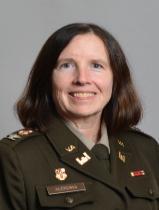
Associate Professor
Biology
Expertise: Plant metabolism, biofuel development from crop residues, genetic engineering
Faculty Positions:
- Associate Professor, VMI Biology, 2014 to 2014
- Assistant Professor, VMI Biology, 2008 to 2014
- Visiting Assistant Professor, Washington and Lee, 2007-2008
- Visiting Assistant Professor, James Madison University, 2006-2007
- Visiting Assistant Professor, Lynchburg College, 2005-2006
- Adjunct Professor, Bridgewater College, 2004-2005
- VMI Awards Faculty Development Leave, Fall 2012: “Selecting a soybean cultivar for genetic engineering of biofuel traits, with opportunities for cadet research.”
- USDA Post-Doctoral Fellowship, Virginia Tech, 2002-2004: “Investigating the roles of flavonols in plants through molecular analyses of flavonol synthase isoforms.”
Publications:
- Alerding, A.B. and *R.M. Hunter “Increased springtail abundance in a garlic mustard invaded forest,” accepted by Northeastern Naturalist in October 2012.
- *Waalkes, M.R. and A.B. Alerding. 2011. Possible chemical attractant to white tail deer in Campanulastrum americanum. New Horizons: VMI Journal of Undergraduate Writing 5:79-88.
- Alerding, A.B. Garlic mustard: friend or foe? Virginia Native Plant Society Upper James River Chapter Newsletter, Spring 2011, pp. 3-5.
- Owens, D.K., A.B. Alerding, K.C. Crosby, A.B. Bandara, J.H. Westwood, and B.S.J. Winkel. 2008. Functional analysis of a predicted flavonol synthase gene family in Arabidopsis. Plant Physiology 147:1046-1061.
Research:
- Conducting research, especially as a mentor to undergraduates, is an invigorating part of my position at VMI. The foundation of my research program is its interdisciplinary nature. I am a plant biologist trained in physiological, molecular, ecological, and biochemical techniques and it is the hypothesis that drives my research rather than the organism. Focusing on how plants partition carbon resources acquired by photosynthesis to produce unique chemistries, I have worked on unicellular algae, parsley cells in suspension culture, tobacco, soybean, and the genetic model, Arabidopsis. I have completed a project examining community ecology aspects of an invasive species, garlic mustard, and its impact on understory forest communities. Currently, my laboratory is one of three components of the new VMI CLEAR (Clean Energy and Air Resources) center that Drs. Moore, Pennington and I began in fall 2011. This center is working to train a workforce of students to develop sources of sustainable energy from plant biomass residues. The other components are housed in Civil Engineering Department, optimizing biofuel production from crop residues, and in the Department of English and Fine Arts which focuses on developing communication skills in our trained researchers. The research that I am conducting involves the development of a genetically modified plant, the Virginia soybean, to will produce high seed yield and optimized cell wall biomolecules enabling use of its stem residues as a fuel crop. My goal is to apply fundamental knowledge about plant chemistry to the genetic engineering of a dual-use food and fuel crop plant to be cultivated on the same plot of land.
Col. Wade E. Bell, Ph.D.
Professor
Director and Secretary to VMI Research Labs
Ph.D. - University of Vermont
Specialty: Eukaryotic Microbiology
214 Maury-Brooke Hall
540-464-7432
bellwe@vmi.edu
Sarah A. Bennell
Administrative Assistant
303E Maury-Brooke Hall
540-464-7247
bennellsa@vmi.edu
Col. Mark Bryant
Instructor
Master of Strategic Studies, U.S. Army War College 2003
303F Maury Brooke Hall
540-464-7510
bryantmh@vmi.edu
Col. Mark Bryant

Expertise: Biological Safety and Security. Chemical and Biological Warfare/Terrorism Threat analysis and Doctrinal Response. Environmental Science and System Modeling. Leadership education, Development and Organizational Development.
Research: Significant Background in Intelligence Community Research and Analysis and Production of classified Estimates at the level of the National Intelligence Council and Defense Intelligence Analysis Program.
- Adjunct in Biology since 2016, teaching introductory biology for non-majors. Developed and Taught Course in Biological Agents in Warfare and Terrorism since 2019.
- Leadership Fellow for the Center for Leadership and Ethics Teaching core Couse in Leadership (LEAD 344) to all Cadets.
- Assistant Instructor in the Rat Challenge Program for New Cadets and for Corps marksmanship program.
Interests: Virginia Master Naturalist Program; Veterans Organizations; VMI Alumni affairs.
Maj. Alison K. Burke, Ph.D.
Assistant Professor
Health Professions Advisor
Ph.D. - Virginia Tech
Specialty: Molecular Microbiology
301C Maury-Brooke Hall
540-464-7928
burkeak@vmi.edu
Maj. Alison K. Burke, Ph.D.
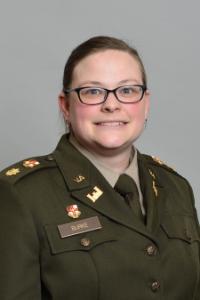
Assistant Professor
Biology
Expertise: Molecular Biology, Microbiology, Virology, Cell Biology
Faculty Positions:
- Assistant Professor, VMI Biology 2024-Current
- Biology Instructor, VMI Biology 2020-2024
- Visiting Assistant Professor, Ferrum College, 2018-2020
- Biology Instructor and Program Director for Sciences, ECPI University Roanoke Campus, 2016-2018
- Visiting Assistant Professor, Hampden-Syndey College 2016
- Adjunct Assistant Professor, Virginia Tech, 2015-2018
Publications
- Submitted for Review: Joud Aldaroub, Chrissy M. Walsky, Rylee E. Ewell, Frank O. Aylward, Ann M. Stevens, and Alison Kernell Burke. Isolation and characterization of four novel Vibrio parahaemolyticus bacteriophages from oysters. Submitted to PLoS One September 2025.
- Christopher J. Rawson, London Nemmers, Stacey Criswell, Ashleigh B. Smythe, Alison K. Burke, Eugene Marais, Gillian Maggs-Kolling, Amy M. Treonis. Description of Panagrolaimus namibiensis sp. (Rhabditida: Panagrolaimidae), an Anhydrobiotic Nematode from the Namib Desert of Namibia. J Nematology Oct. 2024;56(1):20240039.
- Holly Packard, Alison Kernell Burke, Roderick V. Jensen, Ann M. Stevens. Analysis of the in planta transcriptome expressed by the corn pathogen Pantoea stewartii Stewartii via RNA-Seq. PeerJ April 2017.
- Kernell Burke, A, Duong, DA, Jensen, RV, and Stevens AM. Analyzing the Transcriptomes of Two Quorum-Sensing Controlled Transcription Factors, RcsA and LrhA, Important for Pantoea stewarti PLoS One Dec. 2015.
- Kernell Burke A, Guthrie LTC, Modise T, Cormier G, Jensen RV, McCarter LL, Ann M. Stevens (2015) OpaR Controls a Network of Downstream Transcription Factors in Vibrio parahaemolyticus PLoS ONE 10(4): e0121863.
- Ramachandran, R., Kernell Burke, G. Cormier, R. V. Jensen, and A. M. Stevens. 2014. Transcriptome-based analysis of the Pantoea stewartii quorum-sensing regulon and identification of EsaR direct targets. Appl Environ Microbiol 80:5790- 5800.
- Jensen, R. V., S. M. Depasquale, E. A. Harbolick, T. Hong, L. Kernell, D. H. Kruchko, T. Modise, C. E. Smith, L. L. McCarter, and A. M. Stevens. 2013. Complete Genome Sequence of Prepandemic Vibrio parahaemolyticus BB22OP.
Biography
Maj. Alison Burke is an Assistant Professor of Biology and the Health Professions Adviser at Virginia Military Institute. She earned her Ph.D. in Biological Sciences from Virginia Tech, where she studied quorum sensing in Vibrio parahaemolyticus, an emerging seafood-borne pathogen. Her research focuses on bacterial communication, bacteriophage therapy, and environmental microbiology, with current projects exploring phage-based methods to reduce Vibrio contamination in oysters and collaborative metagenomic studies of marine and terrestrial ecosystems.
As VMI’s Health Professions Adviser, Maj. Burke mentors cadets pursuing medical, dental, veterinary, and other allied health-related careers. She provides individualized academic advising, helps students navigate application processes, and builds partnerships with professional programs including Eastern Virginia Medical School at ODU, Virginia Commonwealth University, Mary Baldwin University, and Texas A&M University Military Medicine Program.
Maj. Burke is passionate about connecting students to meaningful research and experiential learning opportunities that prepare them for future careers in science and health. Her expertise includes molecular biology, microbial genomics, phage biology, and undergraduate research mentorship.
Shannon Carter
Instructor
M.S. - Johns Hopkins University
Specialty: Introductory Biology
303F Maury-Brooke Hall
540-464-7003
cartersa@vmi.edu
Col. Emily L. Fadia, Ph.D.
Professor
Ph.D. - Massachusetts Institute of Technology & Woods Hole Oceanographic Institution
Specialty: Genetics and Molecular Biology
303D Maury-Brooke Hall
540-464-7423
fadiael@vmi.edu
Col. Emily L. Fadia, Ph.D.
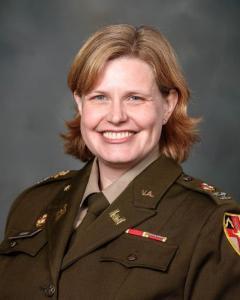
Professor
Biology
Expertise: Molecular biology, genetics, and DNA biogeography of the distribution of noxious microorganisms
Faculty Positions:
- UMass Dartmouth, Biology Department, 2005-2009
Longwood University, Department of Biological and Environmental Science, 2009-2010
Virginia Military Institute, 2010-Present - NASA Exobiology Post-Doctoral Fellow, Harvard University, Department of Organismic and Evolutionary Biology, 2003-200
Eileen T. Hinks, Ph.D.
Instructor
Ph.D. - Temple University
Specialty: Biochemistry
405B Maury-Brooke Hall
540-464-7427
hinkset@vmi.edu
Eileen T. Hinks, Ph.D.

Instructor
Biology and Chemistry
Lt. Col. Molly H. Kent, Ph.D.
Director, VMI Center for Undergraduate Research
Assistant Professor
Ph.D. - University of Illinois Urbana - Champaign
Specialty: Neuroscience
301D Maury-Brooke Hall
540-464-7567
kentmh@vmi.edu
Lt. Col. Molly H. Kent, Ph.D.

Dr. Molly Kent is an Associate Professor of Biology at the Virginia Military Institute, where she teaches courses in introductory biology, neuroscience, physiology, and endocrinology. She earned her Ph.D. in Neuroscience from the University of Illinois at Urbana-Champaign and her B.S. in Biology with an emphasis in Neuroscience from the University of Wisconsin–Madison. Dr. Kent’s research explores neurobiological and behavioral adaptations to stress and environmental complexity, with a particular focus on comparative studies between wild and laboratory animals. Her work has been published in leading journals such as Frontiers in Behavioral Neuroscience, Hormones and Behavior, and Neuroscience. A passionate mentor, she has guided over 30 undergraduate research projects and numerous honors theses, fostering student engagement in scientific inquiry. Dr. Kent is also active in professional service, currently serving on the Executive Council of the International Behavioral Neuroscience Society and as Director of the VMI Center for Undergraduate Research. Her teaching and research have been recognized with multiple institutional and international commendations for excellence and innovation.
Dr. Moshe Khurgel, Ph.D.
Instructor
Ph.D. - University of Toronto
Specialty: Introductory Biology
303F Maury-Brooke Hall
540-462-6471
kurgelm@vmi.edu
Melissa Krawiec, DO
Institute Physician
Instructor
D.O. - West Virginia School of Osteopathic Medicine
Specialty: Introductory Biology
228 Post Hospital
540-464-7218
krawiecms@vmi.edu
Melissa Krawiec, DO

Dr. Melissa S. Krawiec (née Williams) is a board-certified Family Practice physician and Virginia native.
Dr. Krawiec earned her Bachelor of Science in Biology from Virginia Military Institute in 2001 and completed her medical degree at the West Virginia School of Osteopathic Medicine in 2005.
She completed internship at WVU’s Charleston Area Medical Center and family practice residency at the University of New England College of Osteopathic Medicine in Maine.
Following several years in Family Practice and Urgent Care in the Portland, Maine area, Dr. Krawiec joined the U.S. Department of State as a Regional Medical Officer. She served two overseas tours in this capacity, in New Delhi, India and Warsaw, Poland, respectively.
Following over a decade of service in the U.S. State Department she is thrilled to join the VMI family and give back to the Institute in such a meaningful way.
Lt. Col. Mary Beth Manjerovic, Ph.D.
Associate Professor
Ph.D. - University of Central Florida
Specialty: Disease Ecology
301F Maury Brooke Hall
540-464-7931
manjerovicme@vmi.edu
Lt. Col. Mary Beth Manjerovic, Ph.D.
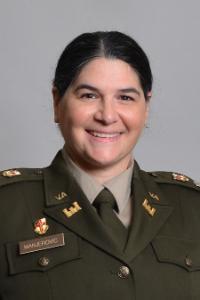
Associate Professor
Biology
Col. Paul R. Moosman, Jr. '98, Ph.D.
Professor
Ph.D. - Auburn University
Specialty: Field Biology
301E Maury-Brooke Hall
540-464-7433
moosmanpr@vmi.edu
Col. Paul R. Moosman, Jr. '98, Ph.D.
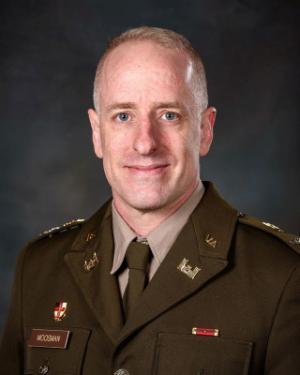
Professor
Biology
Teaching: I teach courses ranging from introductory biology to upper level courses such as ecology, vertebrate biology, biostatistics, environmental issues, and tropical marine biology. Many of my upper-level courses have a strong experiential/field component to provide hands-on learning opportunities and encourage a deeper level of understanding.
Research: Bat Ecology and Conservation
Publications:
- Moosman, P.R., Jr., E.K. Pody*, D.M. Marsh, and T.J. Brust*. 2023. Differential selection of roosts by Eastern Small-footed Myotis relative to rock structure and microclimate. Journal of Mammalogy https://doi.org/10.1093/jmammal/gyad037
- Grilliot, M.E., Tracy, W.A.*, and Moosman, P.R. 2023. Geographic distribution note of little brown skink (Scincella lateralis) in Rockbridge County, Virginia. Herpetological Review 54 (1)
- Alston, J.M., D.A. Keinath, C.K.R. Willis, C.L. Lausen, J.M. O’Keefe, J.D. Tyburec, H.G. Broders, P.R. Moosman, T.C. Carter, C.L. Chambers, E.H. Gillam, K. Geluso, T.J Weller, D.W. Burles, Q.E. Fletcher, K.J.O. Norquay, and J.R. Goheen. 2023. Environmental drivers of body size in North American bats. Functional Ecology 37:1020-1032. https://doi.org/10.1111/1365-2435.14287
- Reynolds, D.S., K. Shoemaker, S. von Oettingen, S. Najjar, J.P. Veilleux, and P.R. Moosman. 2021. Integrating multiple survey techniques to document a shifting bat community in the wake of white-nose syndrome. Journal of Fish and Wildlife Management 12:395–411. https://doi.org/10.3996/JFWM-20-043
- Moosman, P.R., Jr., D. Marsh, E.K. Pody, M.P. Dannon, and R.J. Reynolds. 2020. Efficacy of visual surveys for monitoring populations of talus-roosting bats. Journal of Fish and Wildlife Management 11:1-12. DOI: 10.3996/122019-NAF-002
- Moosman, P.R., Jr., P.R. Anderson, and M.G. Frasier. 2017. Use of rock-crevices in winter by big brown bats and eastern small-footed bats in the Appalachian Ridge and Valley of Virginia. Banisteria 48:9-13.
- Hann, Z.A., M.J. Hosler, and P.R. Moosman, Jr. 2017. Roosting habits of two eastern red bats (Lasiurus borealis) in the Blue Ridge Mountains of Virginia. Northeastern Naturalist, 24.
- Huth, J.K., A. Silvis, P.R. Moosman, Jr., W.M. Ford, and S. Sweeten. 2015. A comparison of survey methods for documenting presence of Myotis leibii (eastern small-footed bats) at roosting areas in western Virginia. Virginia Journal of Science, 66:413-425.
- Moosman, P.R., Jr., D.P. Warner, R.H. Hendren, M.J. Hosler. 2015. Potential for monitoring eastern small-footed bats on talus slopes. Northeastern Naturalist, 22:1-13.
- Moosman, P. R., Jr., J. P. Veilleux, G. W. Pelton, and H. H. Thomas. 2013. Changes in capture rates in a community of bats in New Hampshire during the progression of white-nose syndrome. Northeastern Naturalist, 20:552-558.
- Thomas, H. H., P. R. Moosman, Jr., J. Pierre Veilleux, and J. Holt. 2012. Foods of bats (Family Vespertilionidae) from five sites in New Hampshire and Massachusetts. Canadian Field-Naturalist, 126:117-124.
- Moosman, P. R., Jr., H. H. Thomas, and J. P. Veilleux. 2012. Diet of the widespread insectivorous bats Eptesicus fuscus and Myotis lucifugus relative to climate and richness of bat communities. Journal of Mammalogy 92:491-496.
- Austin, K. B., P. R. Moosman, and H. H. Thomas. 2011. Eavesdropping on echolocation: Recording the bat's auditory experience. Engineering in Medicine and Biology Society, EMBC, 2011 Annual International Conference of the IEEE, pp.7682-7686, Aug. 30 2011-Sept. 3 2011.
- Sharkey, E. K., A. South, P. R. Moosman, C. K. Cratsley, & S. M. Lewis. 2010. Assessing condition-dependence of male flash signals in Photinus fireflies. Journal of Insect Behavior 23:215-225.
- Moosman, P. R., Jr., C. K. Cratsley, S. D. Lehto, and H. H. Thomas. 2009. Do courtship flashes of fireflies (Coleoptera: Lampyridae) serve as aposematic signals to insectivorous bats? Animal Behaviour 78:1019-1025.
- Austin, K. B., H. H. Thomas, P. R. Moosman, Jr., P. Lustig, B. Crepeau, B. Huff, K. Veasna, M. Tatro, & R. Farnsworth. 2009. Capturing the auditory experience of behaving bats: a preliminary study. Proceedings of the International Conference of Computing in Engineering, Science, and Information, pp. 123-126.
- Veilleux, J. P., P. R. Moosman, Jr., D. S. Reynolds, K. A. LaGory, L. J. Walston, Jr. 2009. Observations on summer roosting and foraging behavior of a hoary bat (Lasiurus cinereus) in southern New Hampshire. Northeastern Naturalist 16:148-152.
- Veilleux, J. P., H. H. Thomas, and P. R. Moosman, Jr. 2008. Bats of Pisgah State Park, New Hampshire. Northeastern Naturalist 15:25-34.
- Moosman, P. R., Jr., H. H. Thomas, and J. P. Veilleux. 2007. Food habits of eastern small-footed bats (Myotis leibii) in New Hampshire. American Midland Naturalist 158:354-360.
- Moosman, D. L. and P. R. Moosman, Jr. 2006. Subcutaneous movements of visible implant elastomers in wood frogs (Rana sylvatica). Herpetological Review 37:300-301.
- White, J. A., P. R. Moosman, Jr., C. H. Kilgore, and T. L. Best. 2006. First record of the eastern pipistrelle (Pipistrellus subflavus) from southern New Mexico. Southwestern Naturalist 51:420-422.
- Moosman, D. L., and P. R. Moosman, Jr. 2005. Natural History Note: Bufo americanus, Rana catesbeiana, Microhabitat. Herpetological Review 36:298.
- Moosman, P. R., Jr., D. L. Moosman, and J. C. Pillow. 2005. Geographic distribution. Ambystoma talpoideum (mole salamander). Herpetological Review 36:198.
- Williams, M. I., R. D. Birkhead, P. R. Moosman, Jr., and S. M. Boback. 2004. Agkistrodon piscivorus (eastern cottonmouth) diet. Herpetological Review 35:271-272.
- Palmer-Ball, B., Jr. and P. R. Moosman, Jr. 2002. Some notes from the 2001 breeding season. The Kentucky Warbler 78.
Maj. Peter Neofotis, Ph.D.
Lecturer
Ph. D. - City University of New York
Specialty: Photosynthesis and Algal Biology
301B Maury-Brooke Hall
540-464-7434
neofotispg@vmi.edu
Dr. Billy J. Parson
Instructor
M.D. - University of Louisville
Specialty: Introductory Biology
303F Maury Brooke Hall
540-464-7932
parsonbj@vmi.edu
Dr. Billy J. Parson
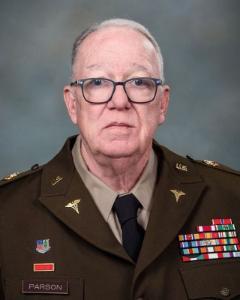
Instructor
Biology
Natalie B. Slone, M.S.
Instructor
M.S. - University of Missouri
Specialty: Comparative Nutrition
303 F Maury-Brook Hall
slonenb@vmi.edu
Col. Ashleigh B. Smythe, Ph.D.
Department Head of Biology
Professor
Ph.D. - University of California, Davis
Specialty: Invertebrate Zoology & Parasitology
303E Maury-Brooke Hall
540-464-7934
smytheab@vmi.edu
Col. Ashleigh B. Smythe, Ph.D.
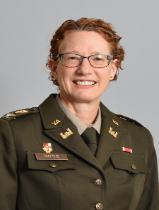
Professor
Biology
Expertise: Parasitology, Invertebrate Zoology, Nematology, Evolutionary biology, systematics, and taxonomy, Marine free-living nematodes
Research: My research focuses on the evolution and ecology of invertebrate animals. While my primary research interest is in the evolution and diversity of free-living nematodes, students in my lab also research other invertebrates, especially parasites.
Free-living marine nematodes — Marine sediments support by far the greatest diversity of nematode species, and I aim to understand their diversity, evolution, and taxonomy.
Parasite ecology and evolution — My students and I study a variety of parasitic worms. Examples include the diversity and distribution of leeches infecting turtles, the community of parasites in muskrats, and the attraction of a beetle host to a larval tapeworm.
Select publications:
- Mohammed Ahmed, Nickellaus G. Roberts, Funmilola Adedidran, Ashleigh B. Smythe, Kevin M. Kocot and Oleksandr Holovachov. 2022. Phylogenomic analysis of the phylum Nematoda: conflicts and congruences with morphology, 18S rRNA, and mitogenomes. Frontiers in Ecology and Evolution, Vol. 9, January, 2022.
- Ashleigh B. Smythe. 2020. Nematoda and Pan-Nematoda. In: First Book of Phylogenetically Defined Names: A Companion to the PhyloCode. K. de Queiroz, P. Cantino, and J. Gauthier, eds. University of California Press.
Ashleigh B. Smythe, Oleksandr Holovachov, Kevin M. Kocot. 2019. Improved phylogenomic sampling of free-living nematodes enhances resolution of higher-level nematode phylogeny. BMC Evolutionary Biology 19:121. - Elizabeth S. Hill, Ashleigh B. Smythe, Deborah A. Delaney. 2015. Assessing the role of environmental conditions on efficacy rates of Heterorhabditis indica (Nematoda: Heterorhabditidae) for controlling Aethina tumida (Coleoptera: Nitidulidae) in honey bee (Hymenoptera: Apidae) colonies: a citizen science approach. Journal of Economic Entomology volume 109 (1).
- Ashleigh B. Smythe. 2015. Evolution of feeding structures in the marine nematode order Enoplida. Integrative and Comparative Biology 55(2): 228-240.
- Soraya Naem and Ashleigh B. Smythe. 2015. Tegumental ultrastructure of adult Quinqueserialis quinquiserialis (Trematoda: Notocotylidae): an intestinal parasite of muskrat (Ondatra zibethicus). Parasitology Research 114 (7): 2473-2480.
- Ashleigh B. Smythe, Kristin Forgrave*, Amanda Patti*, Rick Hochberg, and Marian Litvaitis. 2015. Untangling the ecology, taxonomy, and evolution of Chaetogaster limnaei (Oligochaeta: Naididae) species complex. Journal of Parasitology 101(3) p. 320-326. (*Undergraduate co-author)
- Inga A. Zasada, Amy Peetz, Dana K. Howe, Larry J. Wilhelm, Daravuth Cheam, Dee R. Denver, Ashleigh B. Smythe. 2014. Using mitogenomic and nuclear ribosomal sequence data to investigate the phylogeny of virus-vectoring Xiphinema americanum-group nematodes. PLoS One Vol. 9 (2).
- Ashleigh B. Smythe. 2012. Nematological Examination. In: Standard Methods for the Examination of Water and Wastewater. Ed. S. J. Posavec. 22nd ed. American Public Health Association Washington, DC, American Water Works Association.
- Ashleigh B. Smythe and W. Duane Hope. 2008. Nematodes of Plummers Island, Maryland. Bulletin of the Biological Society of Washington 15(1): 13-19.
- Ashleigh B. Smythe, Michael J. Sanderson, and Steven A. Nadler. 2006. Nematode small subunit phylogeny correlates with alignment parameters. Systematic Biology 55(6): 972-992.
- Ashleigh B. Smythe and Steven A. Nadler. 2006. Molecular phylogeny of Acrobeloides and Cephalobus (Nematoda, Cephalobina) reveals paraphyletic taxa and recurrent evolution of simple labial morphology. Nematology 8(6): 819-836.
- Steven A. Nadler, Paul De Ley, Manuel Mundo-Ocampo, Ashleigh B. Smythe, S. Patricia Stock, Dan Bumbarger,
- Byron J. Adams, Irma Tandingan De Ley, Oleksandr Holovachov, and James G. Baldwin. 2006. Phylogeny of Cephalobina (Nematoda): Molecular evidence for recurrent evolution of probolae and incongruence with traditional classifications. Molecular Phylogenetics and Evolution 40 (3):696-711.
- A.B. Smythe and W.F. Font. 2001. Phylogenetic analysis of Alloglossidium (Digenea: Macroderoididae) and related genera: Life-cycle evolution and taxonomic revision. Journal of Parasitology 87 (2): 386-391.
Col. James E. Turner '65, Ph.D.
Professor Emeritus and Stanley Visiting Chair in Ethics and Integrity
Ph.D. - University of Tennessee
Specialty: Neuroscience
303C Maury-Brooke Hall
540-464-7436
turnerje@vmi.edu
Col. James E. Turner '65, Ph.D.
Professor
James E. Turner, Ph.D.
Biology
Faculty Positions:
- Wake Forest University School of Medicine, Department of Anatomy and Cell Biology, 1978-1992
- University of North Texas Health Science Center, Department of Anatomy and Cell Biology (Department Chair), 1992-2000
- Virginia Military Institute, Department of Biology (Department Chair), 2000-Present
- Sabbatical Leave, NIH Career Development Award, Max Planck Institute for Neurochemistry, Munich, Germany, 1980-81: Neurotropic factors in goldfish optic nerve regeneration
- NIH Post-Doctoral Trainee, Case Western University, School of Medicine, 1972-74: Regeneration in the salamander optic nerve
Publications:
- Turner, JE 2005 The Institutionalization of Undergraduate Research at the Virginia Military Institute (VMI). CUR Quarterly, 25 (3): 108-112.
- Yang-Hsi Tsai, Jaime L. Heimbegner, John J. Beck, and James E. Turner, 2006, Herbal extracts from Cortex mountain exhibits antioxidant potential, inhibits T cell-induced apoptosis, and possess antimicrobial activities. J Undergraduate Chem. Res., 5(1):33-40.
- Alia Hamad, Matthew Kluk, Joshua Fox, Matthew Park, and James E. Turner, 2007, The Effects of Aromatase Inhibitors (Als) and Selective Estrogen Receptor Modulators (SERMs) On Eye Development in the Zebrafish (Danio rerio). Current Eye Research, 32:819-827.
- Bryan Nelson, Russ P Henriet, Andrew W. Holt, Katherine C. Bopp, Alexander P.,Houser, Ottei E. Allgood, and James E. Turner, 2008, The Role of Estrogen on the Developmental Appearance of Sensory-Motor Behaviors in the Zebrafish (Danio rerio): The Characterization of the "Listless" Model. Brain Res., 1222:118-128.
- Alexander Houser, Christopher McNair, Ross Piccinini, Andrew Luxhoj, Wade E. Bell and James. E. Turner. 2011. Effects of Estrogen on the Neuromuscular System in the Embryonic Zebrafish (Danio rerio). Brain Res. 1381:106-11.
Research:
- Working with zebrafish: We have established a zebrafish-breeding colony, which we will use as our experimental animal model. The zebrafish just got a big splash in "Science Magazine" because it is one of the premier animals to be used in genomics and molecular biology. This is because of its rapid development as an embryo and its transparent mature which makes it ideal for analyzing treatments of various types or gene alterations whose effects can be visually recognized in these animals.
- Trophic factors in the development and recovery of the damaged nervous and cardiovascular systems: I have been fortunate during my research career to have pioneered a new field in the visual sciences, retinal transplantation, which now has its own section at national and international vision meetings. I have also been pleased to see my biomedical findings translated into clinical research in this area. I have been awarded over $3.5 million in grant funding to support this work from public, private, and industrial sources and published over 100 scientific papers.
Co-Curricular Interests:
- Mentor in VMI Student Community Service Activities. I have the pleasure of directing VMI's CORE Initiative. CORE stands for Community Outreach and Renewal Experience. This initiative, guided by the VMI Service Committee and the student-led Rotaract Club, helps facilitate cadet, faculty, and staff engagement in local, regional, national, and international volunteer community service opportunities.
- Mentor in Undergraduate Research. It is my passion to encourage a love of learning and the spirit of scientific inquiry. At VMI I have had the pleasure of being the founding director of both the Fred C. Swope Summer Scholar Research Program in Biology and VMI's Center for Molecular, Cellular and Biological Chemistry, as well as founding and institutionalizing VMI's Undergraduate Research Initiative. My greatest joy is mentoring students in my research lab which involves a unique way of teaching them unique problem-solving skills and engaging them in real-world science questions. My students regularly present their results at regional and national meetings and are co-authors on my publications in scientific journals.
.svg)
.png)


